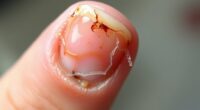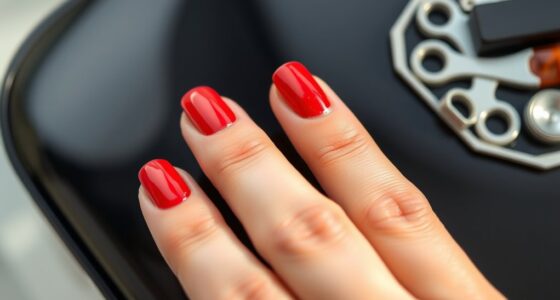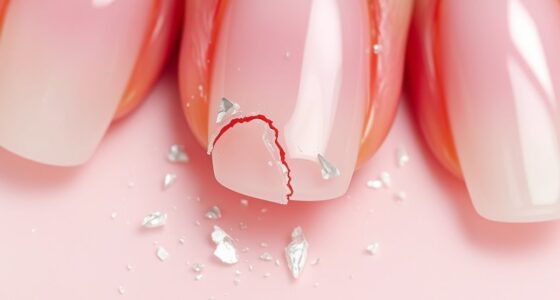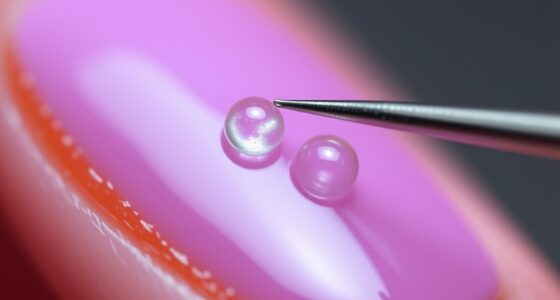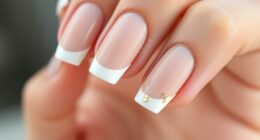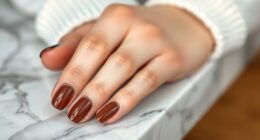If your nail falls off, keep the exposed nail bed clean and dry by gently washing it with mild soap and water, then pat it dry. Cover it with a sterile bandage to protect against dirt and further injury, and change the dressing daily. Use gentle pain relief like over-the-counter medication and elevate your hand or foot to reduce swelling. Watch for signs of infection, and follow proper wound care to support healing; more tips await if you continue exploring.
Key Takeaways
- Keep the exposed nail bed clean and dry, washing gently with mild soap and water, then patting dry.
- Cover the area with a sterile bandage and change it daily or when dirty to prevent infection.
- Manage pain with over-the-counter medications and apply cold packs wrapped in cloth for swelling relief.
- Watch for signs of infection like increased redness, swelling, pus, or foul odor, and seek medical attention if needed.
- Avoid trauma, use protective gear during activities, and follow proper wound care to promote healing and prevent complications.

If you have an exposed nail bed, taking proper care is essential to prevent infection and promote healing. When your nail falls off, the open area can be vulnerable to bacteria and dirt, increasing the risk of infection. To protect yourself, keep the area clean and dry at all times. Gently wash with mild soap and water, and pat it dry with a clean towel. Avoid using harsh chemicals or alcohol-based products, as they can irritate the delicate skin and delay healing. Applying an antibiotic ointment can create a barrier that helps prevent infection, but only do this if recommended by a healthcare professional. Cover the exposed nail bed with a sterile bandage to shield it from dirt and accidental bumps that could cause further injury. Change the dressing daily or whenever it becomes wet or dirty, ensuring the area stays clean and dry. Using a sterile technique during dressing changes can help reduce the risk of contamination and infection.
Pain management is another critical aspect of caring for an exposed nail bed. You might experience discomfort or throbbing, especially when pressure is applied or if the area becomes inflamed. Over-the-counter pain relievers like acetaminophen or ibuprofen can help reduce pain and swelling. Applying a cold pack or ice wrapped in a cloth for 10-15 minutes can also provide relief. Be cautious not to apply ice directly to the skin to avoid frostbite. Elevating your hand or foot can minimize swelling and throbbing, making you more comfortable. If pain persists or worsens despite these measures, consult a healthcare provider promptly. They can assess whether you need additional treatment, such as stronger medication or professional cleaning.
You should also pay attention to signs of infection, like increased redness, swelling, warmth, pus, or a foul odor. If you notice any of these symptoms, seek medical attention immediately. Proper hygiene and cautious handling of the exposed nail bed are your best defenses against complications. Avoid picking at the area or removing any scabs, as this can reopen the wound and prolong healing. Keep the area protected from further trauma by avoiding activities that may jar or injure it further. Wearing protective gloves or padding during activities can help.
Finally, be patient. Healing of the exposed nail bed takes time, often several weeks, depending on the severity of the injury. During this period, maintaining good hygiene, managing pain, and preventing infection are your priorities. Proper wound care and diligent attention to hygiene will support your body’s natural healing process and reduce the risk of complications, leading to a healthier recovery.
Frequently Asked Questions
How Long Does It Take for a Nail Bed to Fully Heal?
You’re wondering how long it takes for your nail bed to fully heal. Typically, the healing timeline varies, but nail regeneration usually takes about 3 to 6 months for a new nail to fully grow back, depending on the extent of injury. During this time, your nail bed undergoes a healing process that includes tissue repair and regeneration. Be patient, keep the area clean, and avoid trauma to support proper healing.
Can I Use Nail Polish on an Exposed Nail Bed?
Your exposed nail bed is as delicate as a butterfly wing, so you might wonder if you can use nail polish on it. It’s best to avoid nail polish safety until it heals, as chemicals can irritate or infect the area. For DIY nail bed care, keep it clean and protected. Using polish prematurely can delay healing and cause more damage, so give your nail bed time to recover fully before applying any polish.
When Should I See a Doctor for My Exposed Nail Bed?
You should see a doctor if you notice signs of infection like increased redness, swelling, pain, or pus around your exposed nail bed. Also, seek medical care if the area isn’t showing signs of nail bed regeneration after a few days or if it worsens. Prompt treatment helps prevent complications and supports proper healing, ensuring your nail bed recovers fully and reduces the risk of infection.
Are There Specific Foods to Promote Nail Healing?
You want to know which foods promote nail healing. Focus on nutrient-rich foods like lean proteins, fruits, and vegetables to support recovery. Incorporate collagen-boosting diets with foods like bone broth, eggs, and fish to help rebuild your nail bed. Staying well-hydrated and avoiding processed foods also aid healing. Eating a balanced diet with these nutrients speeds up recovery and strengthens your nails naturally.
How Can I Prevent Infection During Recovery?
To prevent infection during recovery, you should focus on proper hygiene by gently cleaning the exposed nail bed with mild soap and water. Apply antiseptic ointments as recommended by your healthcare provider to reduce bacteria. Avoid touching or picking at the area, and keep it covered with a sterile bandage. Regularly change dressings, and watch for signs of infection like redness or swelling. Staying vigilant helps guarantee a safe healing process.
Conclusion
Now that your nail’s gone, picture the tiny, delicate bed beneath—vulnerable yet resilient. With gentle care, keep it clean and protected, like wrapping a fragile seed before it blooms. Imagine each day as nurturing sunlight and nourishing rain, helping your nail bed heal and grow anew. Though it may seem bare and exposed now, trust in the process and patience—soon, a new nail will rise, reclaiming its place like a quiet promise of renewal.

